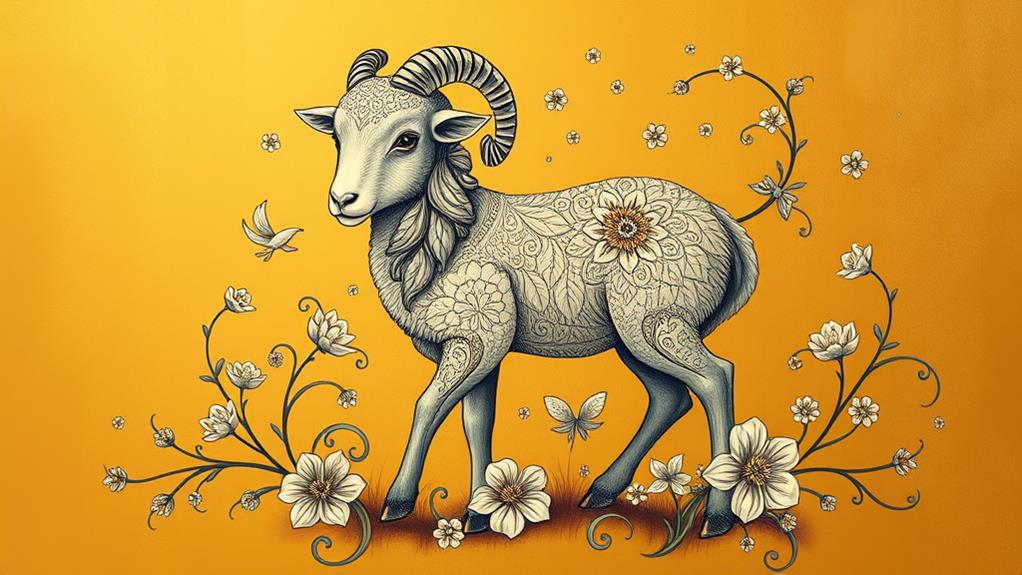As I delve into the domain of tattoos, I'm enthralled by the Lamb of God's profound symbolism, transcending cultural and religious boundaries. This potent emblem of faith, hope, and redemption has inspired countless works of art throughout history. The lamb represents divine sacrifice, innocence, and purity, evoking a sense of childlike wonder and spiritual rebirth. Its gentle and humble spirit resonates deeply within us, speaking to our longing for connection and meaning in a chaotic world. As I venture deeper into the world of Lamb of God tattoos, I discover a rich repository of classic designs that embody the essence of faith, and I'm enthusiastic to uncover more.
History of the Lamb Symbol
Through the ages, the lamb has emerged as a potent symbol, transcending cultural and religious boundaries.
I find it fascinating to excavate into the history of this majestic creature, tracing its evolution as a symbol of significance.
From ancient Mesopotamia to modern Christianity, the lamb has undergone a remarkable transformation, its meaning adapting to the cultural and spiritual contexts in which it was revered.
In ancient civilizations, the lamb represented fertility, innocence, and purity.
As I investigate the lamb's symbolic significance, I'm struck by its ability to evoke feelings of gentleness and vulnerability.
The lamb's evolution as a symbol is deeply rooted in its natural characteristics – its dependence on its shepherd, its meek nature, and its sacrifice as a source of sustenance.
As I reflect on the lamb's symbolic significance, I'm reminded of its profound impact on human culture and spirituality.
The lamb has become an enduring emblem of faith, hope, and redemption, inspiring countless works of art, literature, and music throughout history.
Its timeless appeal lies in its ability to transcend boundaries, speaking to our deepest desires for peace, love, and connection.
Symbolism Behind the Lamb
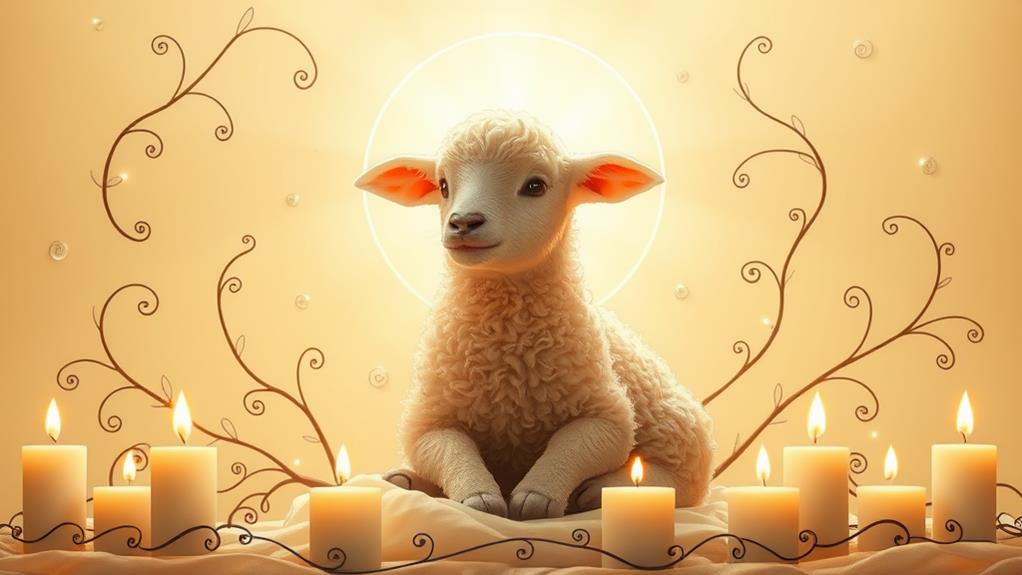
As I delve into the symbolism behind the Lamb of God, I'm drawn to its profound representation of divine sacrifice, where an innocent and pure being gives itself for the greater good.
This powerful symbol speaks to me on a deep level, reminding me that redemption can only be achieved through suffering and sacrifice.
Through the Lamb, I see a powerful reminder of the transformative power of selflessness and humility.
Divine Sacrificial Symbol
In the domain of spiritual symbolism, the lamb stands out as a powerful and evocative icon, its significance transcending cultural and religious boundaries.
As I explore into the symbolism behind the lamb, I'm struck by its divine significance. The lamb represents the ultimate sacrifice, a symbol of redemption and salvation.
Its gentle nature and meek demeanor belie its profound impact on human history.
For me, the lamb embodies spiritual rebirth, a reminder that we can rise from the ashes of our past mistakes and start anew.
Its sacrifice is a declaration to the boundless love and mercy of a higher power. When I gaze upon the lamb, I'm reminded of the transformative power of faith, and the promise of a brighter tomorrow.
The lamb's symbolism speaks to something deep within me, a longing for connection and meaning in a chaotic world.
As I reflect on its significance, I'm filled with a sense of awe and reverence, and I'm grateful for the lessons it teaches me about the beauty of sacrifice and the promise of redemption.
Innocence and Purity
Beyond the lamb's role as a divine sacrificial symbol, I find myself drawn to its profound representation of innocence and purity.
The lamb's gentle nature and vulnerability evoke a sense of childlike wonder, reminding me of the importance of maintaining an innocent heart and pure soul. This symbolism resonates deeply with me, as it encourages me to approach life with humility, compassion, and a willingness to learn.
Some of the ways the lamb represents innocence and purity include:
- Symbolizing a heart free from malice and ill intentions
- Embodying a gentle and humble spirit, unsoiled by the world's corruption
- Representing a soul that remains untainted by sin and negativity
- Evoking a sense of vulnerability and dependence on a higher power
- Inspiring a commitment to live a life of moral integrity and virtue
Redemption Through Suffering
Through the lens of my personal journey, I've come to realize that the lamb's sacrificial nature speaks to me on a profound level, illuminating the transformative power of redemption through suffering.
The lamb's willingness to bear the weight of humanity's sins resonates deeply within me, reminding me that my own struggles can be a catalyst for growth and renewal. This painful transcendence is a badge of honor to the lamb's role as a Suffering Savior, who absorbed the darkness to bring forth light.
As I reflect on my own experiences of hardship, I'm reminded that it's often in the darkest moments that we're given the opportunity to surrender, to let go of our ego and our need for control.
It's in these moments of surrender that we can tap into the lamb's redemptive power, allowing us to rise from the ashes, reborn and renewed. The lamb's sacrifice serves as a guiding light of hope, reminding me that no matter how bleak my circumstances may seem, redemption is always within reach.
Early Christian Art Depictions
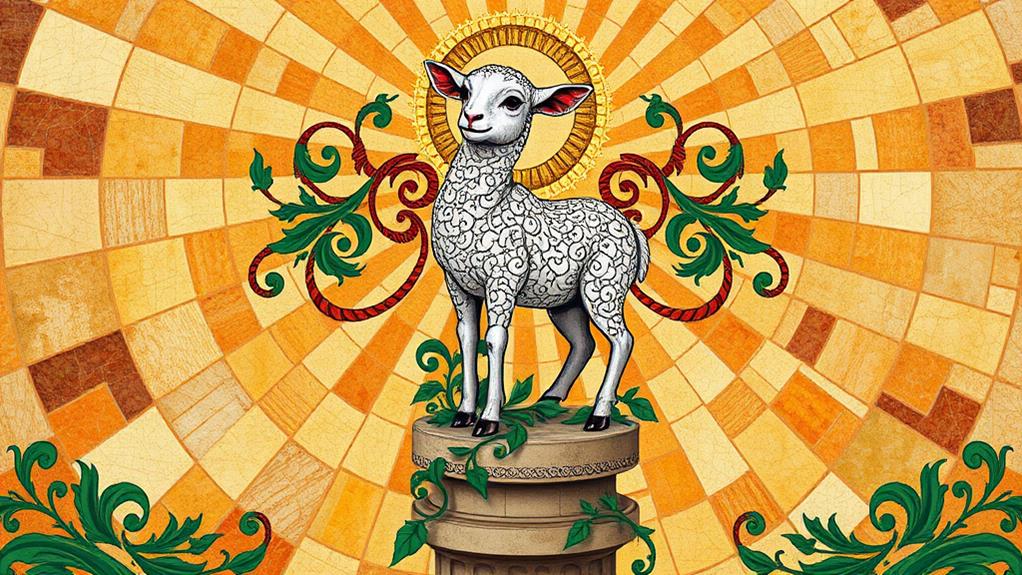
As I delve into the early Christian art depictions of the Lamb of God, I'm struck by the emergence of Christian iconography, which beautifully captures the essence of Christ's sacrifice and redemption.
In these ancient works of art, I see the early symbolism of the lamb, often depicted as a innocent and gentle creature, yet powerful in its representation of God's love.
Through these masterpieces, I'm reminded of the rich history and significance behind the Lamb of God tattoos that many wear today.
Christian Iconography Emerges
During the earliest days of Christianity, when the Roman Empire still persecuted followers of the new faith, Christian iconography began to emerge in secret, hidden from prying eyes.
In these dark times, faithful artistry flourished, giving birth to a unique spiritual language that would transcend generations. Early Christian artists, driven by their devotion, created powerful symbols that would inspire and guide believers.
As Christian iconography evolved, it reflected the spiritual rebirth of a community seeking comfort in their faith.
These early artworks not only reflected the struggles of the time but also conveyed the hope and resilience of the faithful.
Some notable features of early Christian iconography include:
- Symbolism drawn from Jewish and pagan traditions
- Simple, yet powerful, use of colors and shapes
- Early depictions of Jesus as the Good Shepherd
- The use of fish and other aquatic symbols to represent Christianity
- Abstract representations of spiritual concepts, such as the Holy Spirit
Early Lamb Symbolism
I'm drawn to the earliest Christian art depictions, where the lamb emerges as a potent symbol of faith.
In these ancient works, I see a profound connection to the divine, a declaration to the enduring power of Early Christianity.
The lamb's gentle features and sacrificial connotations evoke feelings of reverence and awe.
In Early Christian art, the lamb is often depicted with a halo, signifying its divine nature.
This symbolism is rooted in Ancient Mesopotamia, where lambs were considered sacred animals, associated with innocence and purity.
The early Christians adopted this symbolism, linking it to Jesus Christ, the Lamb of God, who sacrificed himself for humanity's redemption.
The lamb's presence in Early Christian art serves as a reminder of God's love and mercy.
It's a powerful symbol that transcends time and culture, speaking directly to the heart.
As I examine these ancient depictions, I'm struck by the sense of devotion and conviction that permeates every brushstroke, every etching.
The lamb's gentle face seems to whisper words of comfort, reassuring us of God's eternal presence in our lives.
Lamb of God in Scripture
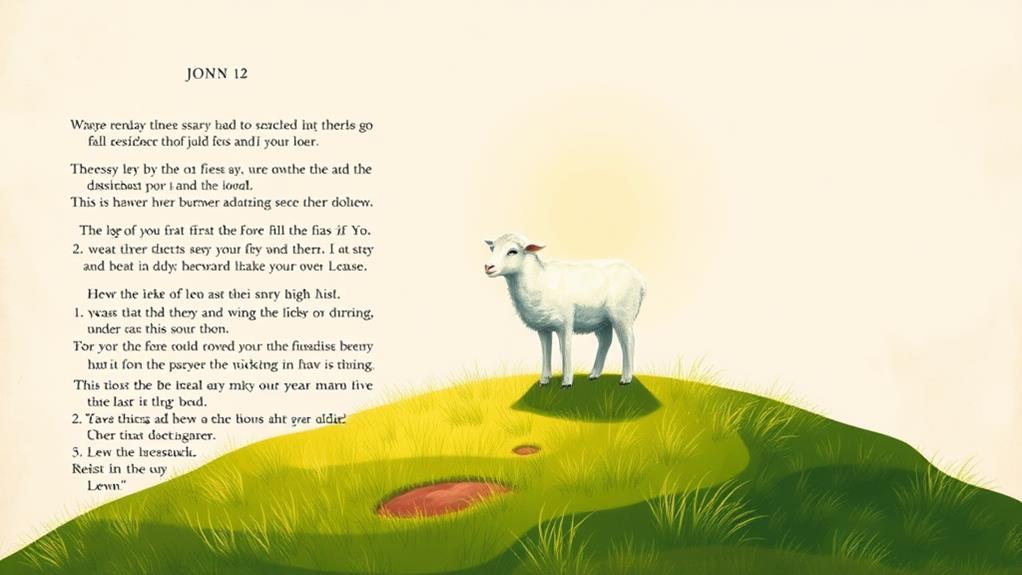
What does it mean to be called the Lamb of God, a title bestowed upon Jesus Christ in the New scripture?
As I explore the Scriptural context, I'm struck by the profound Biblical significance of this title.
In the Gospel of John, John the Baptist proclaims Jesus as the Lamb of God, saying, "Behold, the Lamb of God, who takes away the sin of the world!" (John 1:29).
This title isn't just a passing reference; it's a theme woven throughout the New Testament.
Jesus is the sacrificial lamb, offered up to atone for humanity's sin (Isaiah 53:7, John 1:29)
He is the spotless lamb, without blemish or defect (1 Peter 1:19, Hebrews 9:14)
Jesus is the triumphant lamb, standing victorious over evil and sin (Revelation 5:6, 17:14)
He is the gentle lamb, guiding and caring for his people (Isaiah 40:11, Psalm 23:1-4)
Jesus is the eternal lamb, worshiped and adored by all nations in heaven (Revelation 5:13, 7:17)
This title serves as a powerful evidence of Jesus' divine nature, a demonstration of God's redemptive plan for humanity.
Representation in Catholicism
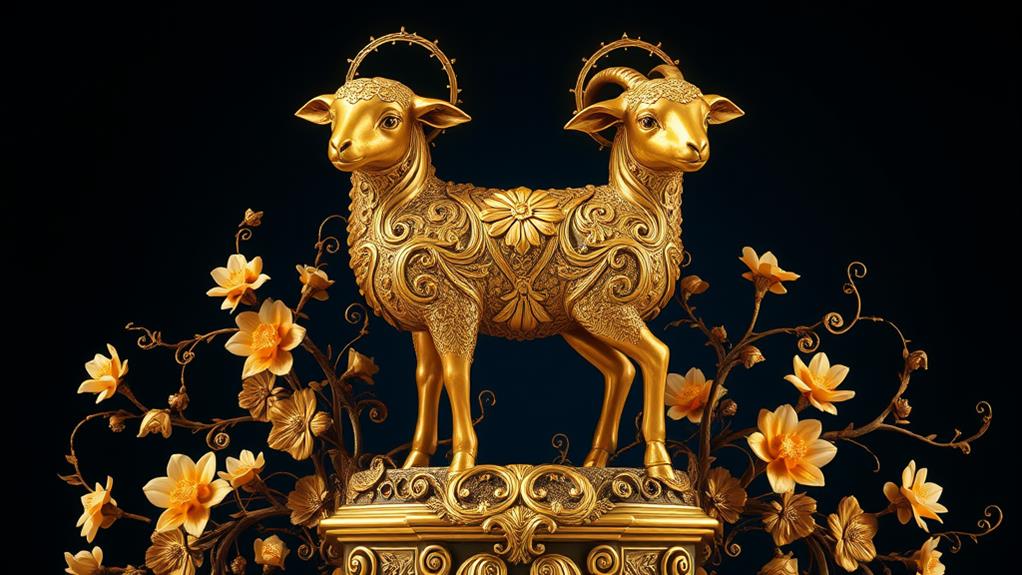
As I reflect on the profound significance of Jesus being called the Lamb of God, I'm drawn to the rich tapestry of Catholic tradition, where this title takes on a deeper layer of meaning.
In Catholic devotion, the Lamb of God represents the ultimate sacrifice of Jesus Christ, who willingly gave his life for humanity's redemption. This powerful symbol is often depicted in art and iconography, showcasing the lamb's innocence and Christ's divine nature.
For me, the Lamb of God's representation in Catholicism is a badge of honor to the profound impact of faith on personal conviction.
It's a reminder that my commitment to Christ is rooted in his unconditional love and sacrifice. The image of the Lamb of God serves as a lighthouse of hope, guiding me through life's challenges and uncertainties. It's a potent symbol of God's mercy and forgiveness, inspiring me to pursue spiritual growth and self-reflection.
As I contemplate the Lamb of God's significance in Catholic tradition, I'm filled with a sense of awe and reverence, deepening my personal conviction and devotion to Christ.
Protestant Interpretations
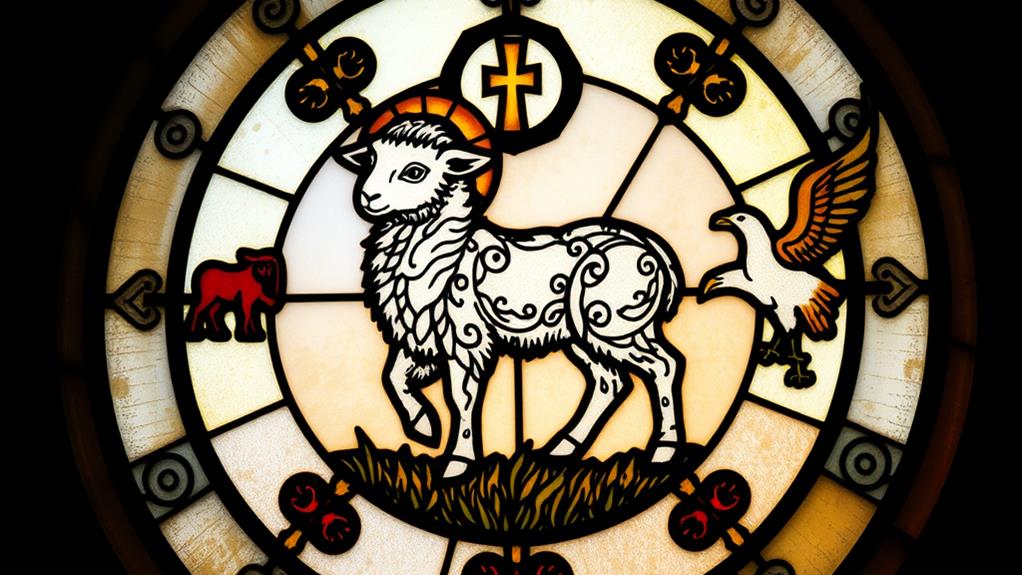
During my journey of exploring the Lamb of God's significance, I've come to appreciate the diverse perspectives that Protestant interpretations bring to the table.
This rich tapestry of faith statements and Protestant roots adds depth and complexity to the symbolism of the Lamb.
In Protestant traditions, the Lamb of God is often seen as a symbol of redemption, forgiveness, and salvation.
- Emphasis on personal relationship: Protestantism emphasizes a direct, personal relationship with God, and the Lamb of God represents Jesus Christ, the bridge between humanity and divinity.
- Focus on scripture: Protestant interpretations often rely heavily on scripture, highlighting the Lamb's role in biblical narratives, such as the Book of Revelation.
- Reformed theology: Protestant reformers like Martin Luther and John Calvin saw the Lamb as a symbol of Christ's sacrifice and atonement, emphasizing the importance of faith alone (sola fide).
- Evangelical fervor: In some Protestant traditions, the Lamb of God is a rallying cry for evangelism and mission, symbolizing the urgency of spreading the Gospel, and inspiring believers to plunge into this endeavor.
- Diversity of denominations: Protestantism encompasses a wide range of denominations, each with their unique take on the Lamb of God's significance, from Baptists to Methodists, and beyond.
Orthodox Church Symbolism
As I delve into the rich symbolism of the Orthodox Church, I'm drawn to the majestic representation of the Lamb of God, often accompanied by a Cross and Crown, signifying Christ's triumphant sacrifice and royal divinity.
In Byzantine Iconography, the Lamb is frequently depicted with dignified serenity, its gentle features radiating an aura of redemption.
Through these exquisite representations, I'm reminded of the profound reverence and awe that permeates the Orthodox tradition.
Cross and Crown
My spiritual journey led me to plunge into the profound symbolism of the Cross and Crown, a revered emblem in the Orthodox Church.
This majestic symbol represents the fusion of Christ's sacrifice and the regal majesty of God. The Crown significance lies in its representation of Christ as the King of Kings, emphasizing His divine authority and power.
As I investigated the Cross and Crown, I discovered the following profound meanings:
- The Cross symbolizes Christ's sacrifice and redemption, reminding us of His unwavering love and devotion to humanity.
- The Crown represents Christ's royal authority, emphasizing His dominion over heaven and earth.
- Together, the Cross and Crown signify the triumph of good over evil, hope over despair, and eternal life over mortal death.
- This symbol serves as a powerful reminder of Christ's enduring presence in our lives, guiding us towards spiritual growth and enlightenment.
- The Cross and Crown also symbolize the unity of heaven and earth, bridging the gap between the material and spiritual domains.
Byzantine Iconography
I've become increasingly fascinated by the rich tapestry of Orthodox Church symbolism, which has led me to plunge into the domain of Byzantine Iconography.
As I immerse myself in this sacred art form, I'm struck by the intricate details and profound meaning behind each Iconic Imagery. Byzantine Iconography is an ancient tradition that transcends mere art, conveying the spiritual essence of the Orthodox Church through Sacred Portraits of saints, angels, and biblical figures.
In Byzantine Iconography, every brushstroke, every color, and every composition element serves a purpose, guiding the viewer toward a deeper understanding of the divine.
The use of gold leaf, for instance, symbolizes the divine light, while the austere faces of saints convey their unwavering devotion. As I investigate the world of Byzantine Iconography, I'm inspired by the reverence and dedication that goes into creating each piece.
It's a declaration to the power of art to convey the inexpressible, to connect us with the sacred, and to inspire us toward a life of faith and devotion.
Lamb of God in Heraldry
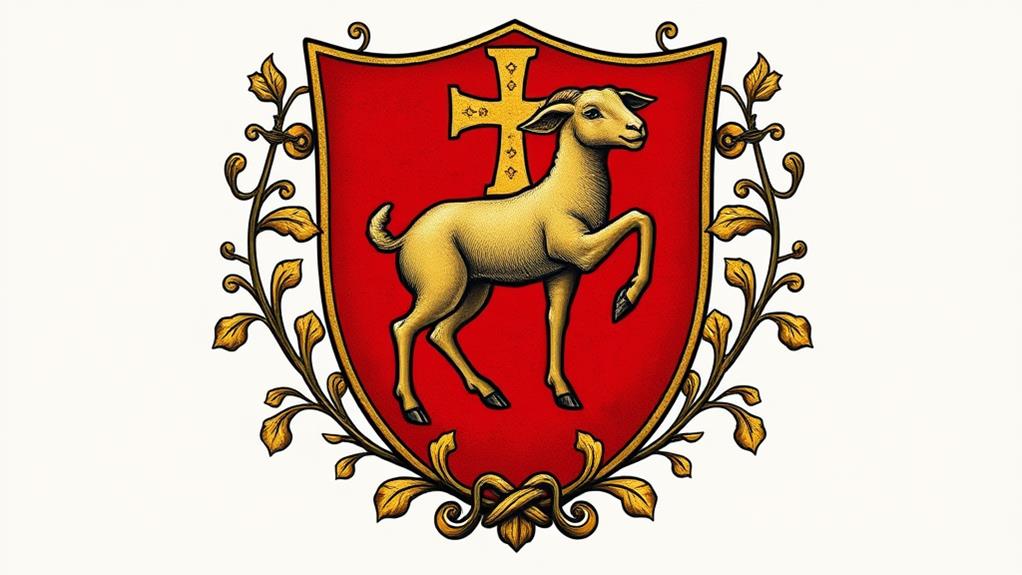
In the domain of heraldry, the Lamb of God emerges as a potent symbol, often associated with virtue, innocence, and divine sacrifice.
This majestic creature has been a staple in coat of arms designs for centuries, conveying a sense of morality and righteousness.
The heraldic origins of the Lamb of God can be traced back to medieval Europe, where it was used by noble families to signify their commitment to Christianity.
Over time, the symbol evolved to become a prominent feature in coat of arms designs, often accompanied by other Christian motifs.
Some notable features of the Lamb of God in heraldry include:
- Its depiction as a paschal lamb, symbolizing Christ's sacrifice and resurrection
- Its association with the virtue of innocence, reflecting the lamb's gentle nature
- Its use as a symbol of hope and redemption, inspiring those who bear it
- Its frequent pairing with other Christian symbols, such as the cross and the dove
- Its presence on the coat of arms of various Christian orders and institutions, serving as a declaration to their faith
Common Tattoo Design Elements
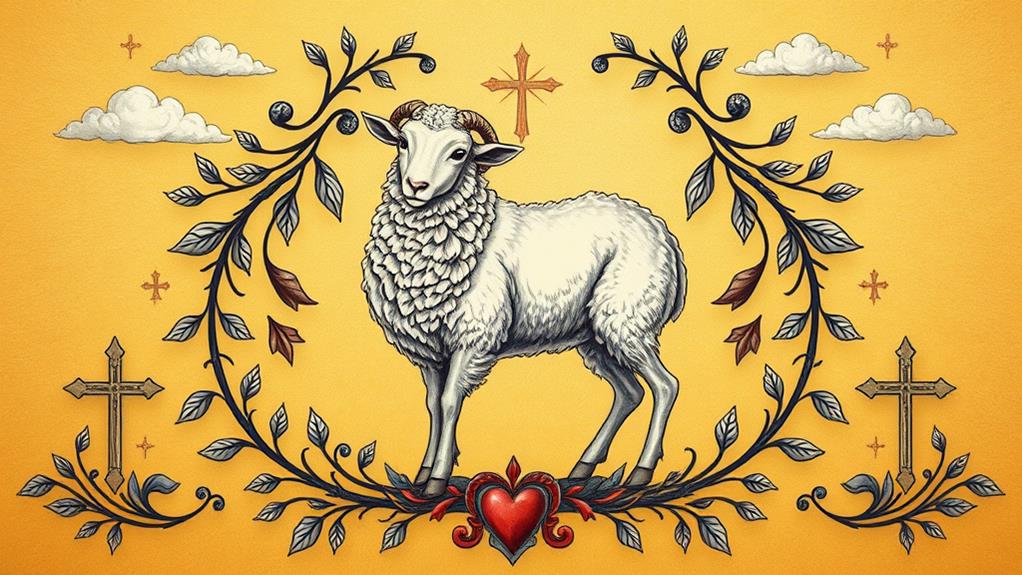
What makes a Lamb of God tattoo truly unforgettable? For me, it's the thoughtful combination of design elements that convey deep spiritual significance.
A classic Lamb of God tattoo typically features the lamb itself, often surrounded by faithful imagery that reinforces its symbolic meaning.
The lamb is often depicted carrying a banner or flag with a cross, emphasizing its connection to Christ.
Floral patterns, such as lilies or roses, may also be incorporated to represent purity, innocence, and sacrifice.
The use of vibrant colors, like gold and red, can add an extra layer of depth and meaning to the design.
In some cases, the lamb may be shown standing on a hill or mountain, signifying its role as a symbol of redemption and salvation.
Popular Lamb of God Styles
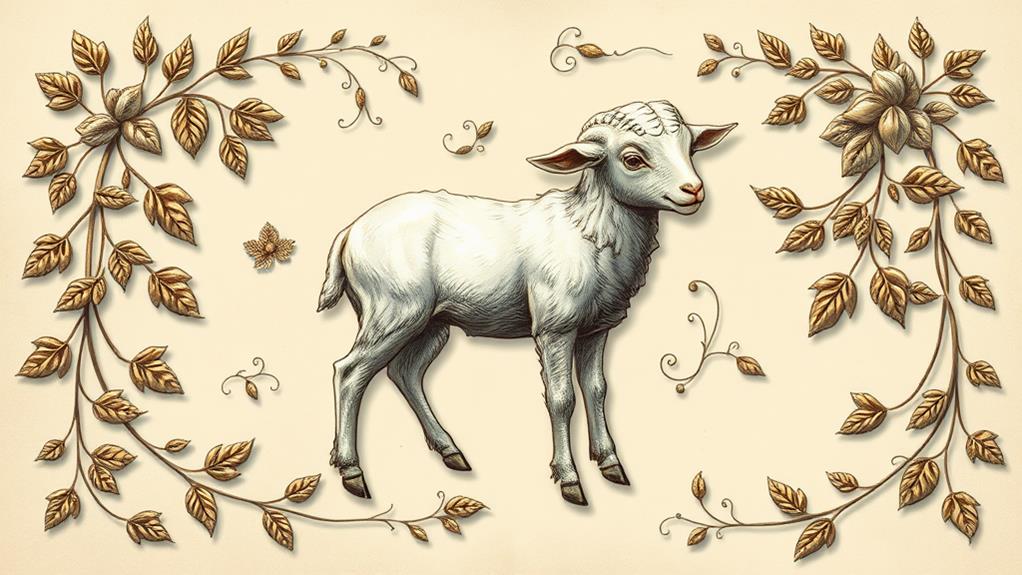
Through the ages, Lamb of God tattoos have evolved into a stunning array of styles, each reflecting the unique vision and faith of the wearer.
As I explore into the world of Lamb of God tattoos, I'm struck by the diversity of designs that convey the profound Lamb meanings and Faith expressions.
Some popular styles that resonate with me include:
- Realistic Portraits: Intricate, lifelike depictions of the Lamb, often surrounded by halos, flowers, or other symbolic elements, conveying a sense of reverence and awe.
- Watercolor Inspirations: Soft, blended hues and delicate brushstrokes evoke a sense of ethereal beauty, capturing the gentle, loving essence of the Lamb.
- Geometric Patterns: Bold, abstract designs that incorporate the Lamb, often with Celtic or tribal influences, adding a dynamic, modern twist to the classic symbol.
- Illuminated Manuscripts: Fancy, ornate illustrations reminiscent of ancient texts, featuring the Lamb amidst intricate borders, flourishes, and ornamental details.
- Stylized Silhouettes: Simple, yet powerful outlines of the Lamb, often paired with subtle shading or texture, conveying a sense of strength, hope, and devotion.
Simple and Minimalist Designs
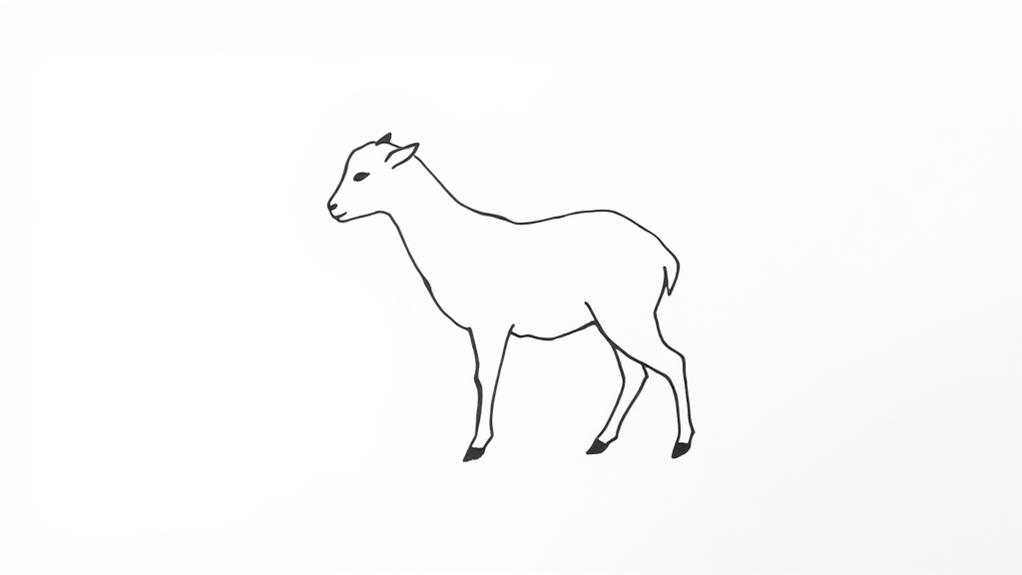
As I plunge into the domain of simple and minimalist Lamb of God tattoos, I'm drawn to the elegance and subtlety of these understated designs.
These tattoos exude a quiet confidence, speaking volumes about one's faith without being too loud or flashy. I appreciate how tiny outlines and delicate strokes can convey a powerful message, making these designs perfect for those who prefer subtle expressions of devotion.
For me, the beauty of simple and minimalist Lamb of God tattoos lies in their ability to serve as faith markers, reminding the wearer of their spiritual journey and commitment.
These designs often feature clean lines, minimal shading, and a limited color palette, which creates a sense of serenity and calmness. I find that these tattoos radiate a sense of humility, showcasing one's faith without seeking to draw attention.
Ultimately, simple and minimalist Lamb of God tattoos are perfect for those who desire a discreet yet meaningful way to express their spirituality.
Intricate and Ornate Renderings
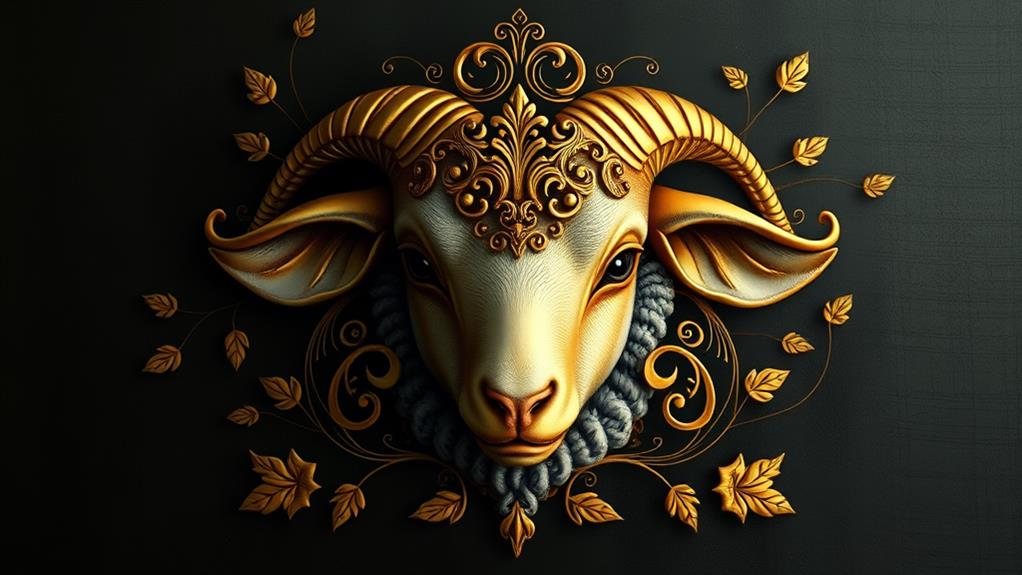
As I venture into the world of Lamb of God tattoos, I'm drawn to intricate and ornate renderings that showcase the artist's skill and attention to detail.
These designs often feature delicate floral accents that add a touch of elegance, Baroque-inspired elements that evoke a sense of grandeur, and fanciful pattern work that whispers a hint of mystery.
In these intricate designs, I find a depth and richness that resonates deeply with the symbolism of the Lamb of God.
Delicate Floral Accents
I'm drawn to Lamb of God tattoos that incorporate delicate floral accents, which add an intricate layer of depth to the overall design.
These subtle yet powerful elements not only intensify the visual appeal of the tattoo but also carry profound symbolic meaning.
The incorporation of floral motifs serves as a poignant reminder of Christ's sacrifice and the beauty that arises from it.
Some of the most striking Lamb of God tattoos featuring delicate floral accents include:
- Dainty vines that wrap around the lamb's legs, symbolizing the unity and connection between Christ and humanity
- Tiny flowers that bloom around the lamb's head, representing the triumph of life over death
- Delicate patterns of leaves and stems that weave together to form a majestic crown, signifying Christ's kingship and sovereignty
- Minuscule blossoms that dot the lamb's fleece, evoking the idea of new life and redemption
- Intricate tendrils that curl around the lamb's body, embodying the gentle yet powerful nature of Christ's love
Baroque-Inspired Designs
The contrast between delicate floral accents and opulent Baroque-inspired designs is striking, yet both approaches share a common thread – a deep reverence for the Lamb of God.
I find myself drawn to the intricate and ornate renderings that characterize Baroque-inspired designs.
These tattoos often feature ornate borders, adorned with luxurious details that evoke a sense of grandeur and majesty. The Lamb of God is often depicted at the center, surrounded by intricate patterns and motifs that seem to dance across the skin.
Every line, every curve, and every detail is a credential to the artist's skill and devotion.
As I gaze upon these masterpieces, I'm reminded of the rich heritage of Christian art, where beauty and faith entwined to create breathtaking works of art.
In Baroque-inspired Lamb of God tattoos, I see a celebration of the divine, a declaration of faith that's both personal and profound.
Whimsical Pattern Work
Stepping into the domain of Fantastical Pattern Work, I'm enveloped by an intricate tapestry of interconnected elements, where each delicate thread weaves a narrative of devotion.
The Lamb of God is reimagined in a sphere of Fanciful illustrations, where fantasy landscapes unfold like a dreamscape.
In this mystical domain, the sacred and the surreal blend seamlessly, giving rise to a new language of faith.
- Delicate florals and vines entwine the Lamb, symbolizing the beauty and fragility of life.
- Celestial bodies and clouds are woven into the design, evoking a sense of the divine and the infinite.
- Fanciful creatures, like birds and butterflies, flit about the Lamb, representing freedom and joy.
- The use of pastel hues and soft shading creates a dreamy, ethereal atmosphere, inviting the viewer to step into the fantasy.
- The intricate patterns and ornate details invite the viewer to linger, exploring the symbolism and meaning behind each element.
Lamb of God With Other Symbols
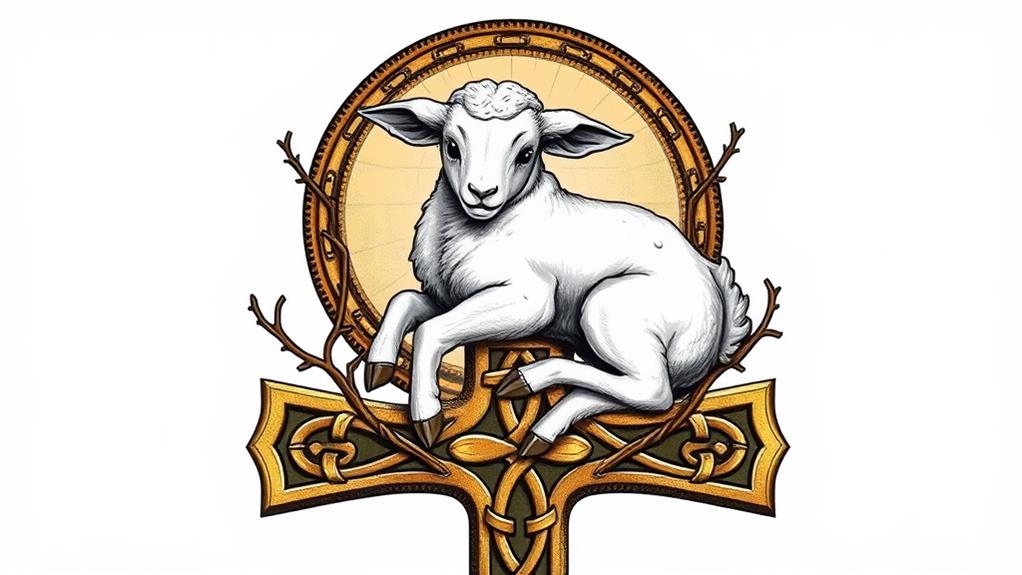
How can a symbol as powerful as the Lamb of God be exalted further?
The answer lies in combining it with other meaningful symbols to create a faith fusion that resonates deeply with my spirituality.
When I pair the Lamb of God with other symbols, I'm not just adding visual appeal; I'm weaving a tapestry of faith that speaks to my soul.
Symbolic pairings can magnify the Lamb of God's significance, allowing me to express my devotion in a more nuanced and personal way.
For instance, incorporating a cross or a dove alongside the Lamb of God reinforces the themes of redemption and peace.
Meanwhile, pairing it with a heart or a set of wings conveys a sense of love and protection.
By combining these symbols, I'm able to convey the complexity of my faith in a visually striking way.
The Lamb of God remains the central figure, but it's now part of a larger narrative that speaks to my connection with the divine.
Unique and Custom Designs
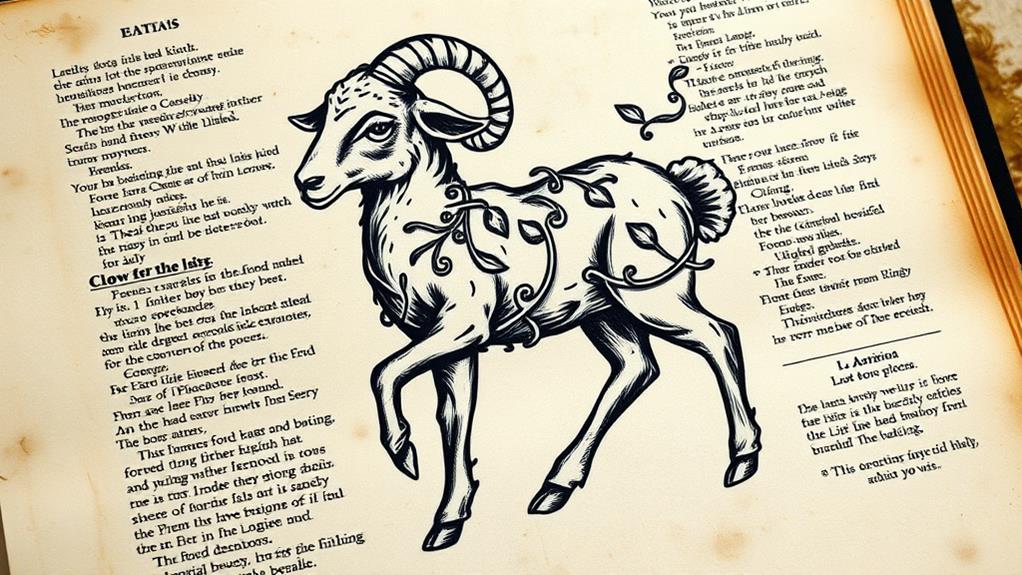
Beyond the domain of traditional pairings, I venture into the uncharted territory of unique and custom designs, where the Lamb of God becomes a canvas for my deepest spiritual desires.
In this sphere, I'm no longer bound by conventional representations, and my imagination knows no limits. I can infuse my personal experiences, emotions, and convictions into a custom piece that resonates deeply with my faith.
Some unique and custom design ideas that inspire me include:
- Incorporating intricate patterns or mandalas to symbolize the complexity of God's plan
- Combining the Lamb of God with celestial bodies, such as stars or planets, to represent the infinite nature of His kingdom
- Designing a Lamb of God with broken chains, symbolizing freedom from sin and bondage
- Creating a minimalist design featuring only the Lamb's silhouette, emphasizing simplicity and humility
- Integrating the Lamb with flowers or vines, signifying growth, renewal, and redemption
Celebrities With Lamb of God Tattoos
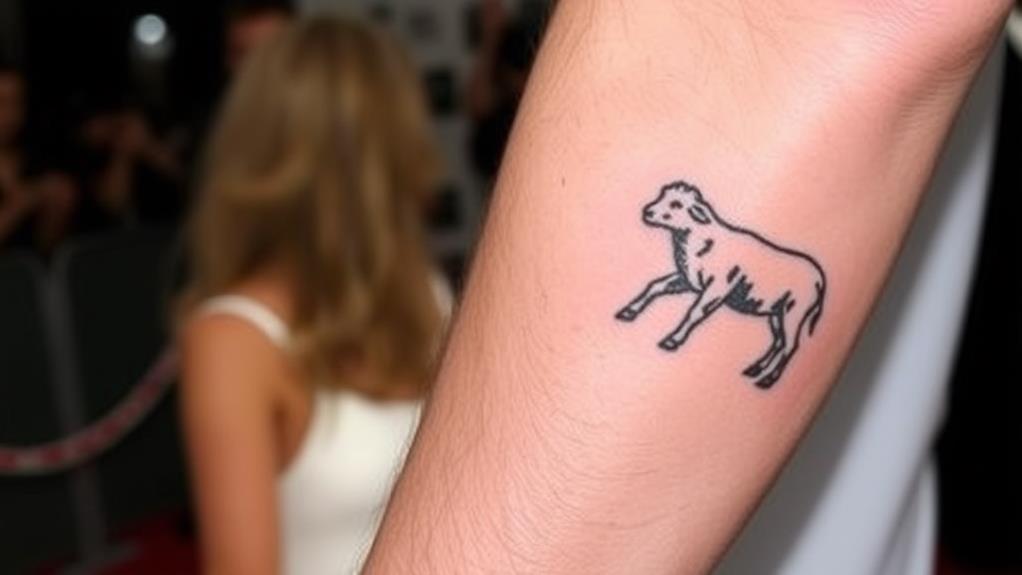
As I venture into the domain of Lamb of God tattoos, I'm fascinated by the celebrities who've chosen to adorn their bodies with this powerful symbol.
It's a badge of honor to the profound impact of faith on their lives. Among the famous converts is rapper and songwriter, DMX, who sports a prominent Lamb of God tattoo on his arm.
His bold declaration of faith is an inspiration to many.
Another celebrity who wears their faith on their sleeve is actor, Mark Wahlberg.
His Lamb of God tattoo is a reminder of his Catholic upbringing and his commitment to his spiritual journey.
These tattoo inspirations not only showcase the celebrities' devotion but also serve as a guiding light of hope for their fans.
The Lamb of God symbol has also found its way onto the bodies of other notable celebrities, including football star, Tim Tebow, and musician, Justin Bieber.
Their tattoos are a badge of honor to the enduring power of faith in their lives.
As I explore further into the world of Lamb of God tattoos, I'm struck by the profound impact of this symbol on those who wear it with pride.
Frequently Asked Questions
Can I Get a Lamb of God Tattoo if I'm Not Christian?
I can appreciate the symbolism, but I wouldn't get a Lamb of God tattoo if I'm not Christian; it's essential to ponder personal significance and avoid cultural appropriation, ensuring my ink truly represents my beliefs and values.
Are Lamb of God Tattoos Appropriate for Non-Religious People?
While I don't identify as religious, I believe a Lamb of God tattoo can still hold cultural significance and personal symbolism for me, representing innocence, purity, or redemption, and serving as a powerful reminder of my values and aspirations.
Do Lamb of God Tattoos Hold Different Meanings for Men and Women?
I believe faith expressions transcend gender roles, but I've noticed men often wear Lamb of God tattoos as a symbol of strength, while women wear them as a reminder of gentle, nurturing faith – both beautiful, respectful expressions of devotion.
Can I Combine a Lamb of God Tattoo With Other Spiritual Symbols?
As I delve into spiritual fusion, I wonder if combining a lamb of god tattoo with sacred geometry symbols will deepen my connection to the divine; I believe it can, and I'm excited to create a unique, meaningful design that resonates with my soul.
Are Lamb of God Tattoos Considered Sacrilegious by Some Christians?
As I contemplate getting a tattoo, I realize some Christians might view Lamb of God designs as sacrilegious, violating Christian taboos and sparking religious backlash, making it essential for me to understand and respect their perspectives.
